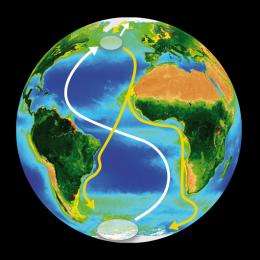Arctic terns confirmed to have the longest animal migration in the world

(PhysOrg.com) -- New information on bird migration is revealed by an international team of scientists who have confirmed that the Arctic tern flies more than 70,000 km on its annual migration trip from pole to pole — the equivalent of three trips to the moon and back over its lifetime.
Scientists from British Antarctic Survey (BAS), Greenland, Denmark, the United States and Iceland, successfully mapped the migratory movements using a tiny tracking instrument known as a geolocater. Weighing just 1.4g this highly specialised device was developed by BAS scientists specifically for tracking animal migration. Already used on other animals such as albatross, penguins and seals, they regularly record light intensity, which can be used to generate two geographical positions per day.
This study confirms that the Arctic tern conducts the longest annual migration in the world as they travel from Greenland to the Weddell Sea on the shores of Antarctica, and back again to their breeding grounds. The birds did not immediately travel south, but spent almost a month at sea in the middle of the North Atlantic Ocean, approximately 1,000 km north of the Azores. After this lengthy stop-over, the birds continued their long journey south down the coast of northwest Africa, but around the Cape Verde Islands the birds’ behaviour surprised the research team again. Approximately half of the birds continued down the coast of Africa, while the other half crossed the Atlantic Ocean to follow a parallel route south down the east coast of South America.
All of the birds spent the northern winter months in Antarctic waters. Interestingly, on their long return journey the birds did not choose the shortest route back to their breeding grounds in Greenland. Instead, the Arctic terns traced out a gigantic ‘S’ pattern northward through the Atlantic Ocean - a detour of several thousand kilometres over a straight line north to their breeding colonies.
Richard Phillips from British Antarctic Survey and co-author of the paper, says,
“The use of these devices on seabirds is not only revolutionising our understanding of migration patterns, but the resulting data on distribution also help address the requirement to identify important biological hotspots.
Our analysis shows that the birds’ behaviour is closely correlated with both biological and physical parameters along the migration route. They paused in their southward migration to spend time in highly productive waters in the middle of the Atlantic Ocean. Compared to this stop-over site, the marine area immediately to the south is lower in productivity.
The indirect ‘S-shaped’ return journey in spring indicates that Arctic terns take full advantage of the prevailing global wind systems to reduce energetic costs on their long flight north.”
Carsten Egevang at the Greenland Institute of Natural Resources, lead author of the paper, says,
“This study on seabird migration has given us an incredibly detailed insight into how long-distance migrants behave at times of the year when it’s normally impossible for us to follow them.”
More information: PNAS: http://www.pnas.org
Provided by British Antarctic Survey


















